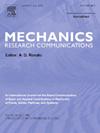Evidence of nonlinearity tailoring in static and dynamic responses of honeycomb and auxetic hourglass lattice metastructures
Abstract
Nature’s morphology and optimal energetic solutions remain the key motivation for designing cellular-based lattice structures. Understanding the nonlinear dynamical behaviors that arise from different lattice topologies of such structures in the metastructure framework is crucial for their successful implementation in various novel designs and technologies related to vibration and shape control. This paper presents a study of the static and dynamic response of auxetic and honeycomb lattices with hourglass or dome-shaped metastructures. The potential tailoring of nonlinearity of such responses through various design parameters that play a vital role in shaping the dynamic properties of such structures is discussed here. The impact of cell design parameters on the resulting macroscopic behavior is assessed using both numerical simulations and experimental studies. The transition from softening to hardening nonlinear dynamic responses is reported with cell topologies ranging from the regular honeycomb to auxetic topologies that are widely used as fundamental cells of cellular materials design. The experimental study is based on the time responses measured to verify the numerical predictions. The experimental system consists of different 3D printed hourglass samples based on the auxetic and honeycomb lattices on which dynamic testing using a laser Doppler vibrometer is performed. The design strategies proposed in this paper can be integrated into a wide range of lattice-based materials for noise and vibration control applications and biomedical devices.

 求助内容:
求助内容: 应助结果提醒方式:
应助结果提醒方式:


